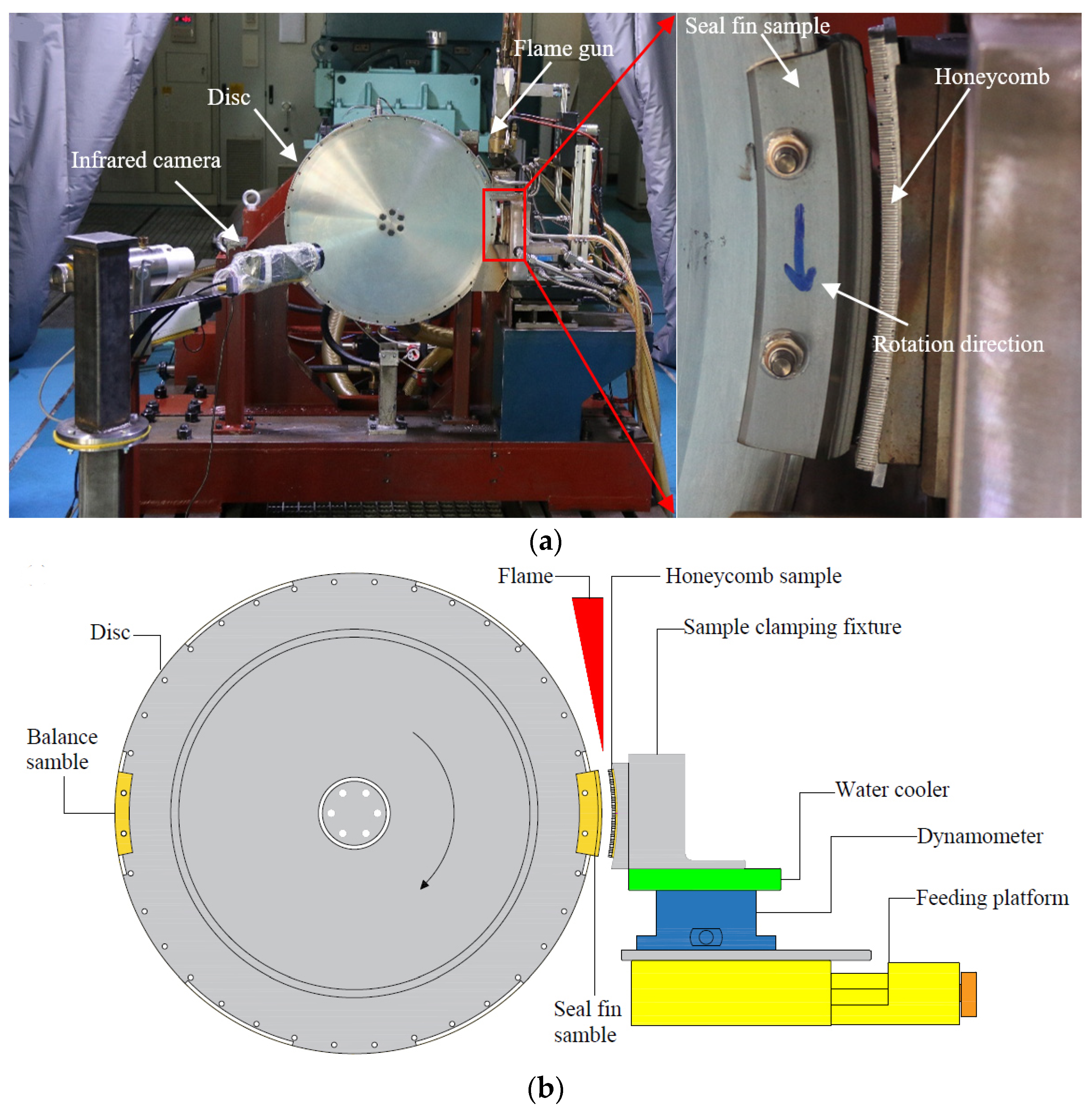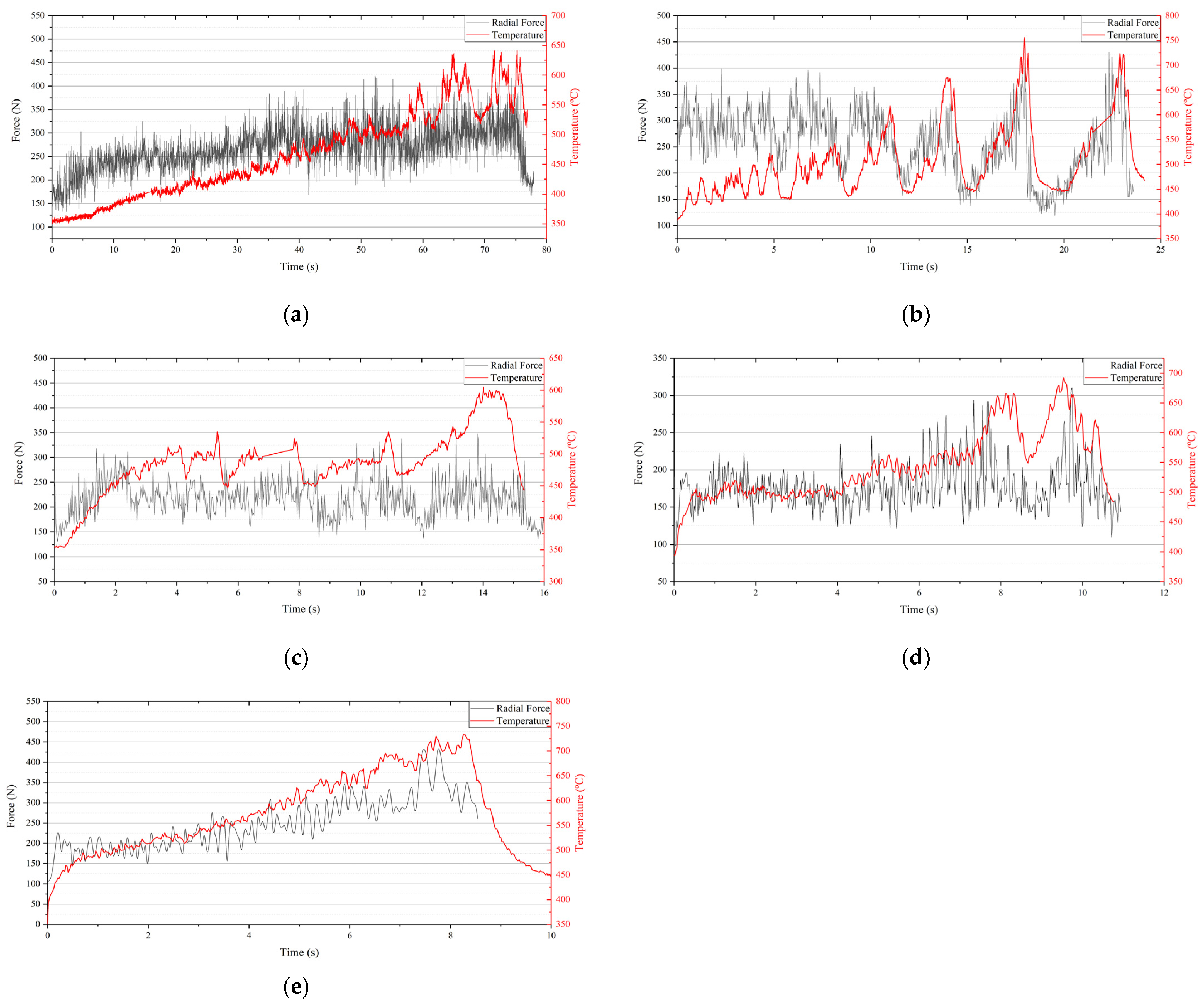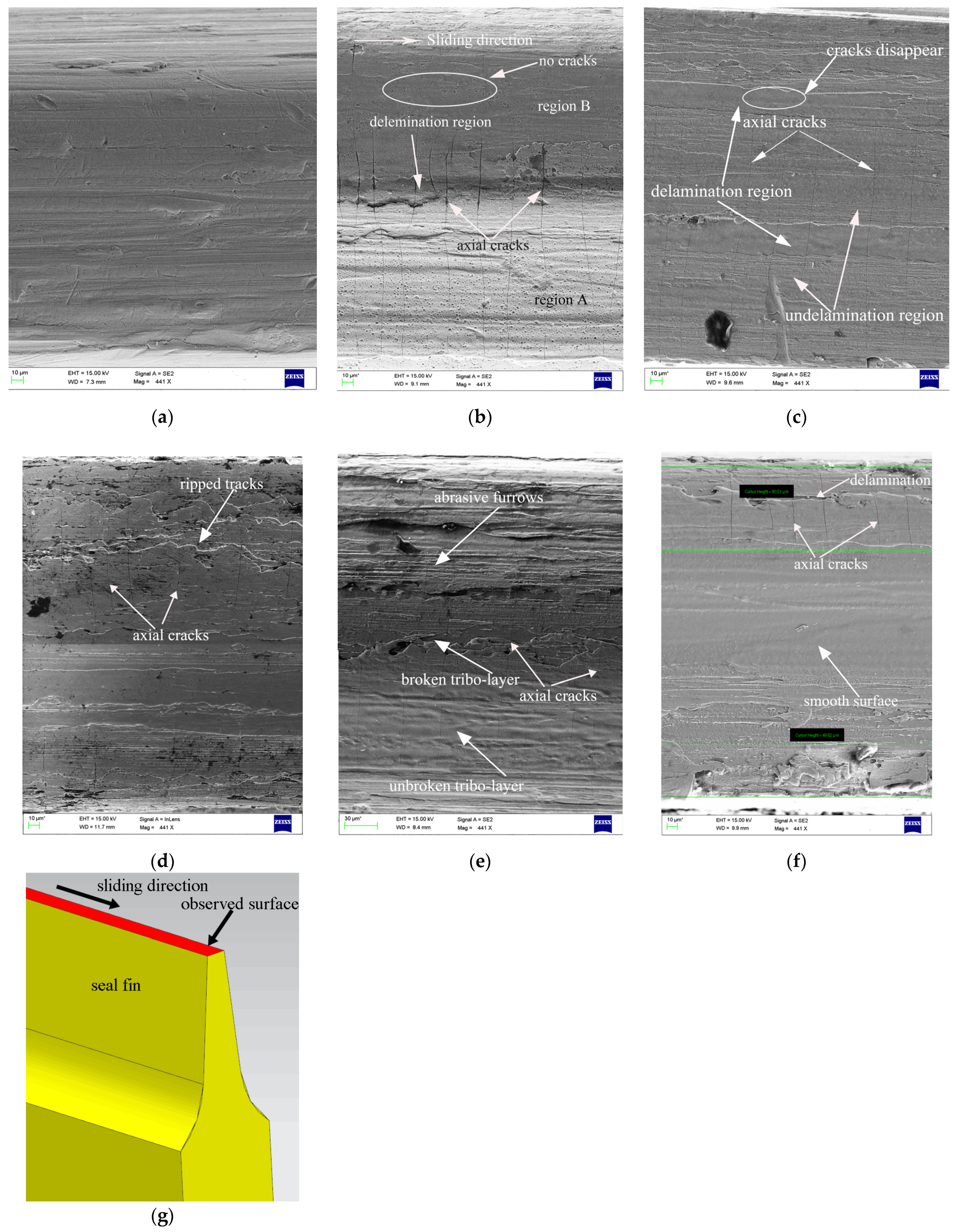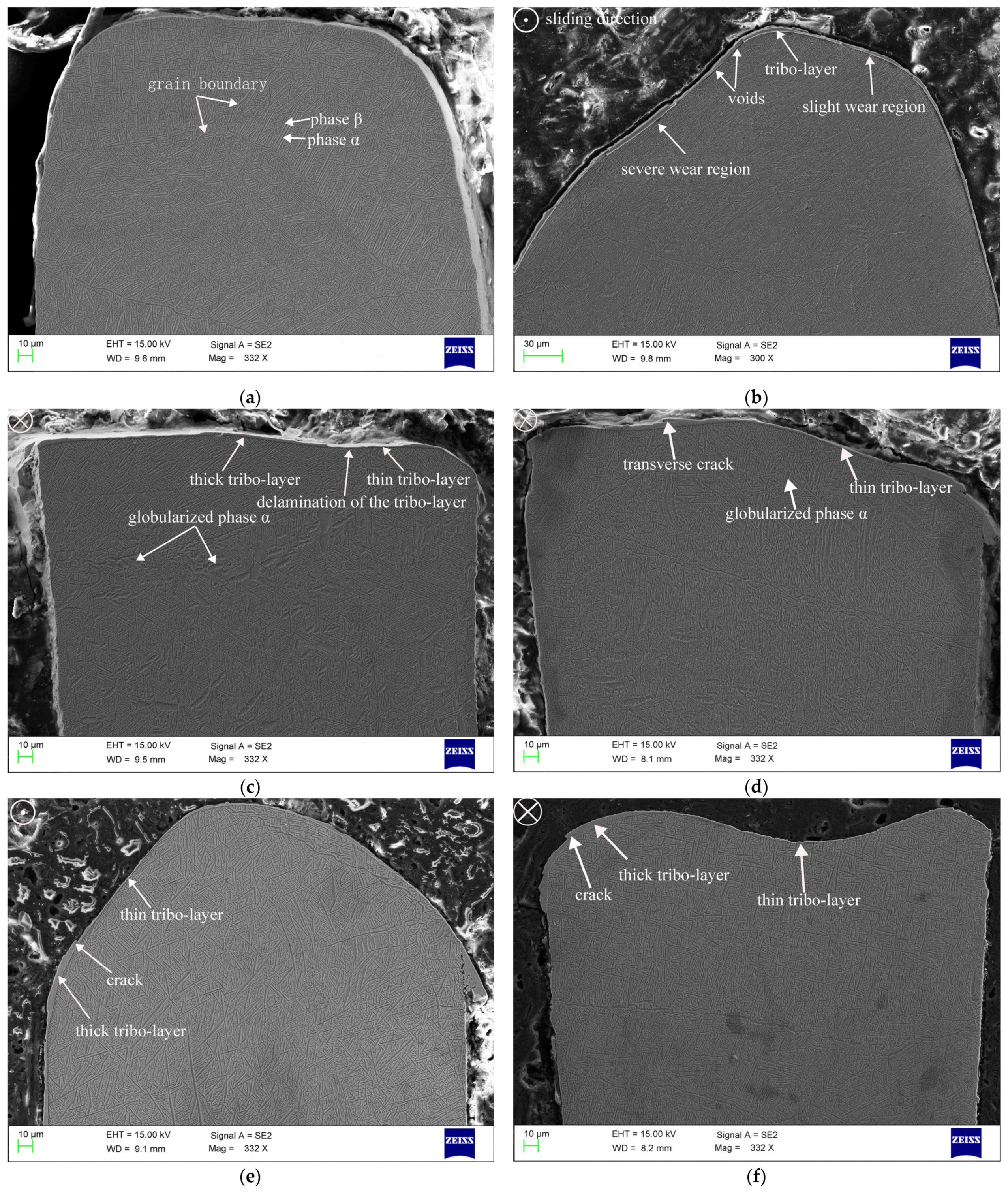The Wear of Seal Fins during High-Speed Rub between Labyrinth Seal Fins and Honeycomb Stators at Different Incursion Rates
Abstract
:1. Introduction
2. Materials and Methods
2.1. Test Rig
2.2. Test Samples
2.3. Test Procedure
2.4. Test Parameters
3. Results
3.1. Rubbing Force and Temperature
3.2. Wear Rate
3.3. Worn Morphology
3.4. Cross-Sectional Morphology of Seal Fin
3.5. EDS Analysis
4. Discussion
4.1. The Wear Mechanism at Different Incursion Rates
4.2. The Causes of the Axial Cracks
4.3. The Relationship between the Wear Mechanism and the Rubbing Force and Temperature
5. Conclusions
- The wear mechanism of the seal fin changes from oxidation wear and adhesive wear at low incursion rates to delamination wear and metal wear at high incursion rates. When oxidation wear and adhesive wear are dominant, the tribo-layer on the contact surface is thick and intact. The tribo-layer protects the seal fin from severe wear. When the delamination wear and metal wear are dominant at high incursion rates, the thin tribo-layer cannot protect the seal fin, resulting in the high wear rate. As a result, the wear rate of the seal fin increases, and the wear rate shows an exponential growth trend with the increasing incursion rate.
- The globularization of α phase occurs on the substrate at 60 μm/s and 100 μm/s, which indicates that frictional heat has a great influence on the substrate. Relatively, the degree of α phase globularization at 60 μm/s is higher than that at 100 μm/s. At high incursion rates, such as 140 μm/s and 180 μm/s, the substrate microstructure is the same as the original microstructure because the rapid wear will carry away the frictional heat.
- The axial cracks appear on the worn surface due to the cracking of the tribo-layer under periodic thermomechanical stress during the rub. The crack propagation is inhibited at 180 μm/s due to the rapid wear of the tribo-layer and short rubbing time. However, at high incursion rates, the tribo-layer and the substrate adhere to and are embedded into each other. The propagation of the axial cracks may lead to the cracking of the substrate, which will endanger the security of the aero-engine. Polishing the worn surface of the seal fin after the rub to remove the cracked tribo-layer is a practical method to eliminate the axial cracks.
- The changes of radial force and temperature with incursion depth correspond to the wear mechanism of seal fins. The periodical large peaks on the curves of rubbing force and temperature indicates that the delamination wear is dominant, while the relatively smooth curves indicate that the metal wear or oxidation wear is dominant.
Author Contributions
Funding
Institutional Review Board Statement
Informed Consent Statement
Data Availability Statement
Conflicts of Interest
References
- E Aslan-Zada, F.; A Mammadov, V.; Dohnal, F. Brush seals and labyrinth seals in gas turbine applications. Proc. Inst. Mech. Eng. Part A J. Power Energy 2012, 227, 216–230. [Google Scholar] [CrossRef]
- Chupp, R.E.; Hendricks, R.C.; Lattime, S.B.; Steinetz, B.M. Sealing in Turbomachinery. J. Propuls. Power 2006, 22, 313–349. [Google Scholar] [CrossRef]
- Denecke, J.; Färber, J.; Dullenkopf, K.; Bauer, H.J. Interdependence of discharge behavior, swirl development and total temperature increase in rotating labyrinth seals. In Proceedings of the 53rd ASME Turbo Expo 2008, Berlin, Germany, 9−13 June 2008; pp. 1717–1724. [Google Scholar]
- Sporer, D.; Fortuna, D. Selecting materials for brazing a honeycomb in turbine engines. Weld. J. 2014, 93, 44–48. [Google Scholar]
- DeMasi-Marcin, J.T.; Gupta, D.K. Protective coatings in the gas turbine engine. Surf. Coat. Technol. 1994, 68, 1–9. [Google Scholar] [CrossRef]
- Jacquet-Richardet, G.; Torkhani, M.; Cartraud, P.; Thouverez, F.; Nouri-Baranger, T.; Herran, M.; Gibert, C.; Baguet, S.; Almeida, P.I.F.; Peletan, L. Rotor to stator contacts in turbomachines. Review and application. Mech. Syst. Signal Process. 2013, 40, 401–420. [Google Scholar] [CrossRef] [Green Version]
- Pychynski, T.; Dullenkopf, K.; Bauer, H.J. Theoretical study on the origin of radial cracks in labyrinth seal fins due to rubbing. In Proceedings of the ASME Turbo Expo: Turbine Technical Conference and Exposition, San Antonio, TX, USA, 3–7 June 2013. [Google Scholar]
- Bill, R.C.; Shiembob, L.T. Some considerations of the performance of two honeycomb gas path seal material systems. Lubr. Eng. 1981, 37, 209–217. [Google Scholar]
- Sporer, D.R.; Shiembob, L.T. Alloy selection for honeycomb gas path seal systems. In Proceedings of the ASEM Turbo Expo 2004: Power for Land, Sea, and Air, Vienna, Austria, 14–17 June 2004; pp. 763–774. [Google Scholar]
- Rathmann, U.; Olmes, S.; Simeon, A. Sealing technology: Rub test rig for abrasive/abradable systems. In Proceedings of the 52nd ASME Turbo Expo 2007, Montreal, QC, Canada, 14–17 May 2007; pp. 223–228. [Google Scholar]
- Zhang, N.; Xuan, H.-J.; Guo, X.-J.; Guan, C.-P.; Hong, W.-R. Investigation of high-speed rubbing behavior of labyrinth-honeycomb seal for turbine engine application. J. Zhejiang Univ. A 2016, 17, 947–960. [Google Scholar] [CrossRef] [Green Version]
- Pychynski, T.; Höfler, C.; Bauer, H.-J. Experimental Study on the Friction Contact Between a Labyrinth Seal Fin and a Honeycomb Stator. J. Eng. Gas Turbines Power 2015, 138, 062501. [Google Scholar] [CrossRef]
- Munz, O.; Pychynski, T.; Schwitzke, C.; Bauer, H.-J. Continued Experimental Study on the Friction Contact between a Labyrinth Seal Fin and a Honeycomb Stator: Slanted Position. Aerospace 2018, 5, 82. [Google Scholar] [CrossRef] [Green Version]
- Zhang, B.; Marshall, M.; Marshallb, M. Investigating the application of a honeycomb abradable lining in the turbine stage of an aero-engine. Tribol. Int. 2018, 125, 66–74. [Google Scholar] [CrossRef] [Green Version]
- Straffelini, G.; Molinari, A. Dry sliding wear of Ti–6Al–4V alloy as influenced by the counterface and sliding conditions. Wear 1999, 236, 328–338. [Google Scholar] [CrossRef]
- Abdel-Aal, A.H. On the interdependence between kinetics of friction-released thermal energy and the transition in wear mechanisms during sliding of metallic pairs. Wear 2003, 254, 884–900. [Google Scholar] [CrossRef]
- Aal, H.A.A. Influence of frictional energy dissipation on wear regime transition in dry tribo-systems. Int. J. Mater. Prod. Technol. 2010, 38, 78. [Google Scholar] [CrossRef]
- Boyer, R.; Collings, E.W.; Welsch, G. Materials Properties Handbook: Titanium Alloys; ASM International: Cleveland, OH, USA, 1994. [Google Scholar]
- Mao, Y.; Wang, L.; Chen, K.; Wang, S.; Cui, X. Tribo-layer and its role in dry sliding wear of Ti–6Al–4V alloy. Wear 2013, 297, 1032–1039. [Google Scholar] [CrossRef]
- Wang, L.; Zhang, Q.Y.; Li, X.X.; Cui, X.H.; Wang, S.Q. Severe-to-Mild Wear Transition of Titanium Alloys as a Function of Temperature. Tribol. Lett. 2014, 53, 511–520. [Google Scholar] [CrossRef]
- Pauschitz, A.; Roy, M.; Franek, F. Mechanisms of sliding wear of metals and alloys at elevated temperatures. Tribol. Int. 2008, 41, 584–602. [Google Scholar] [CrossRef]
- Sabban, R.; Bahl, S.; Chatterjee, K.; Suwas, S. Globularization using heat treatment in additively manufactured Ti-6Al-4V for high strength and toughness. Acta Mater. 2019, 162, 239–254. [Google Scholar] [CrossRef]
- Donzella, G.; Faccoli, M.; Ghidini, A.; Mazzù, A.; Roberti, R. The competitive role of wear and RCF in a rail steel. Eng. Fract. Mech. 2005, 72, 287–308. [Google Scholar] [CrossRef]
- Donzella, G.; Mazzù, A.; Petrogalli, C. Competition between wear and rolling contact fatigue at the wheel—rail interface: Some experimental evidence on rail steel. Proc. Inst. Mech. Eng. Part F J. Rail Rapid Transit 2009, 223, 31–44. [Google Scholar] [CrossRef]










| Composition | Ti | Al | Cr | Zr | Mo | Sn |
|---|---|---|---|---|---|---|
| Content (%) | balance | 5.03 | 3.88 | 1.99 | 4.02 | 2.07 |
| Composition | Ni | Cr | Fe | Mo | Co | Al | W | Si | C | P | Cu |
|---|---|---|---|---|---|---|---|---|---|---|---|
| Content (%) | balance | 21.74 | 19.18 | 8.46 | 1.31 | 0.13 | 0.65 | 0.24 | 0.066 | 0.014 | 0.08 |
| Test No. | Incursion Speed (Vinc, μm/s) | Temperature (T, °C) | Rubbing Speed (Vt, m/s) | Incursion Depth (Dp, μm) |
|---|---|---|---|---|
| I-1 | 20 | 350 | 380 | 1500 |
| I-2 | 60 | |||
| I-3 | 100 | |||
| I-4 | 140 | |||
| I-5 | 180 |
Publisher’s Note: MDPI stays neutral with regard to jurisdictional claims in published maps and institutional affiliations. |
© 2021 by the authors. Licensee MDPI, Basel, Switzerland. This article is an open access article distributed under the terms and conditions of the Creative Commons Attribution (CC BY) license (http://creativecommons.org/licenses/by/4.0/).
Share and Cite
Lu, B.; Ma, X.; Wu, C.; Xuan, H.; Hong, W. The Wear of Seal Fins during High-Speed Rub between Labyrinth Seal Fins and Honeycomb Stators at Different Incursion Rates. Materials 2021, 14, 979. https://doi.org/10.3390/ma14040979
Lu B, Ma X, Wu C, Xuan H, Hong W. The Wear of Seal Fins during High-Speed Rub between Labyrinth Seal Fins and Honeycomb Stators at Different Incursion Rates. Materials. 2021; 14(4):979. https://doi.org/10.3390/ma14040979
Chicago/Turabian StyleLu, Bin, Xiaojian Ma, Caiguang Wu, Haijun Xuan, and Weirong Hong. 2021. "The Wear of Seal Fins during High-Speed Rub between Labyrinth Seal Fins and Honeycomb Stators at Different Incursion Rates" Materials 14, no. 4: 979. https://doi.org/10.3390/ma14040979
APA StyleLu, B., Ma, X., Wu, C., Xuan, H., & Hong, W. (2021). The Wear of Seal Fins during High-Speed Rub between Labyrinth Seal Fins and Honeycomb Stators at Different Incursion Rates. Materials, 14(4), 979. https://doi.org/10.3390/ma14040979





